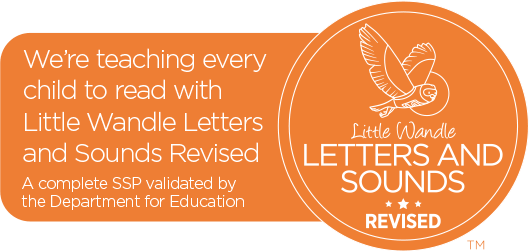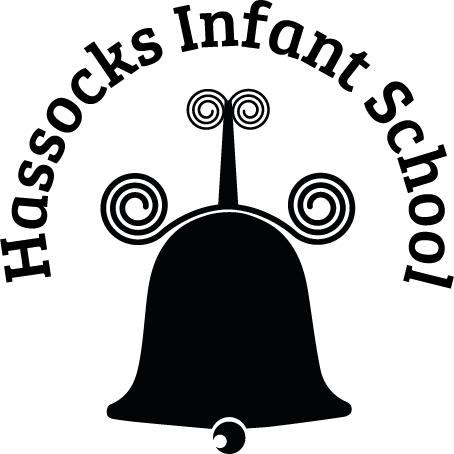Phonics and Reading
Phonics at Hassocks Infant School
At Hassocks Infant School we believe that for all our children to become fluent readers and writers, phonics must be taught through a systematic and structured phonics programme.

We use the Little Wandle Letters and Sounds Revised to plan and provide daily, engaging phonics lessons. In phonics, we teach children that the letters of the alphabet represent a different sound, that these can be used in a variety of combinations and are put together to make words. The children learn to recognise all of the different sounds and combinations that they might see when they are reading or writing. Our phonics teaching starts early in the first few weeks in Reception and follows a very specific sequence that allows our children to build on their previous phonic knowledge and master specific phonic strategies as they move through school. As a result, all of our children are able to tackle any unfamiliar words that they might discover. At Hassocks Infants we also model these strategies in reading practise sessions and writing. We have a strong focus on the development of language skills for our children because we know that speaking and listening are crucial skills for reading and writing in all subjects.
How we teach phonics
-
In reception and Year 1, children follow the progression within the Little Wandle Letters and Sounds Revised programme. (please click here for the progression)..
-
Phonics is taught daily and there is a review session on a Friday. Four new phonemes and their corresponding graphemes are taught (GPCs) each week and they are then used in the final lesson of the week to review the week’s learning. Children will also learn tricky words during these sessions.
-
In Reception, we aim to start phonics in the second week of the Autumn term to ensure that the children make a strong start.
-
In the Autumn and Spring terms, Reception learn phase 2 and phase 3 GPCs and spend the Summer term learning phase 4
-
Year 1 begin the Autumn term with 3 weeks of revision of phases 2, 3 and 4 before learning phase 5, which will be completed by the end of the year.
-
Year 2 children will begin the year by revisiting phase 5 and other previously taught phases to ensure all children are completely confident and then will with applying these GPCs in both their reading and also their writing. (please see the progression grids below).
-
Reception lessons start at 10 minutes, with daily additional oral blending – increasing to 30 minutes as soon as possible.
-
Y1 lessons are 30 minutes long. Sometimes these daily 30-minute sessions may be broken down into two 15-minute sessions.
-
Daily assessment of learning also takes place within the classroom so staff can quickly identify any children who are in danger of falling behind and provide the appropriate daily ‘Keep Up’ intervention. These are short, sharp sessions lasting 10 minutes in length and taking place at least three times a week.
Reading practise sessions
-
Children in Reception, Year 1 and 2, read fully decodable books with an adult 3 times per week during our ‘Reading Practise’ sessions.
-
These sessions are 15 minutes long and happen three times a week. There are approximately 6 children in a group.
-
The sessions follow the model set out in Little Wandle Letters and Sounds Revised.
-
The children then take the same book home at the end of the week to build their reading fluency and showcase their developing skills and phonetic knowledge to their parents/carers
-
These 3 reading practise sessions each have a different focus; decoding, prosody and comprehension.
-
We use fully phonetically decodable Little Wandle Letters and Sounds Revised Big Cat books in all year groups.
-
In reception these sessions start in week 4. Children who are not decoding, do a little blending lesson, following the model set out in Little Wandle Letters and Sound Revised.
How do we assess phonic knowledge?
-
In Reception and year 1, at the end of each week there is a review session which recaps the learning. There are also whole review weeks (pre-planned and bespoke review weeks to address gaps identified by the class teacher’s ongoing formative assessment).
-
Half termly assessments take place through Reception and Year 1 to help inform future teaching and help identify children who have gaps in their phonic knowledge and need additional practise.
-
‘Keep up’ sessions follow the Little Wandle Letters and Sounds Revised programme.
-
Year 1 children sit the National Phonics Screening Check in the summer term.
-
Children who do not pass the Phonics Screening Check in Y1, will re-sit this in Y2. All of these children will be well supported through interventions.
-
Children who are in Year 2 and need ‘catch up’ sessions are assessed through teacher’s ongoing formative assessment as well as half termly summative assessments.
If you are a parent and would like more information about how to support your child with phonics at home, please follow this link to find the Reception and Year 1 overview as well as videos of the sound pronunciations, letter formation sheets and other helpful resources.
https://www.littlewandlelettersandsounds.org.uk/resources/for-parents/
National Phonics Check
During the Summer term in Year 1 children are assessed on their ability to blend phonemes together to read a selection of real and pseudo words. There are 40 words and children need to read at least 32 of these correctly to pass.
The test checks whether children can apply phonics to decode accurately.
Children who do not pass the test in Year 1 are provided with additional support and retake the test in Year 2.
